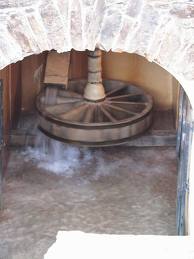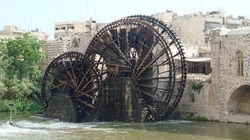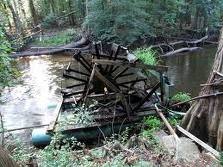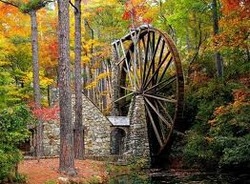Types of Water Wheels
Horizontal Water Wheel
- The horizontal water wheel needs a small volume of water, but needs a high velocity to turn it. It is not very efficient, and derives its motion from the impact of the water hitting its blades. It is suitable for use in areas where there are steep slopes and low volumes of water, like mountain springs. The horizontal wheel is only 15 to 30% efficient at converting the energy of the water in to usable energy transferred through the axle as torque.
Noria(Vertical Wheel)
- The Noria is a vertical type wheel that uses ceramic containers to catch water as they dip into the water at the bottom of the wheels revolution, and it is turned by the force of the water current acting on paddles spaced evenly about the wheel. At the top of the revolution the containers are set up to dump their contents of water out into a canal or aqueduct so that the water can be used for irrigation and other uses. There are still operational Norias being used today in Syria that lift the water as much as thirty meters above the water table.
Undershot Water Wheel(Vertical Wheel)
- The undershot wheel is a vertical type wheel that has its lower part of the wheel is submerged in the current with the current of the water flow acting directly onto the paddles. This is still an impact wheel, but is slightly more efficient than a horizontal wheel. To ensure that a regular supply of water was available, dams were often built and races built directing the water at the wheel to increase power and control of the water.
Breast-shot Water Wheel(Vertical Wheel)
- The breast-shot is a vertical type water wheel which have blades that are shaped to hold water in them as the water enters into them at about one third to two thirds of the height of the diameter of the wheel increasing the amount of force acting on the blades of the wheel thus increasing the torque. The weight of the water acts on the wheel at a distance from the center along with the force of the impact of the water at the bottom of the wheel increasing the efficiency of the wheel. The direction of the wheel spin is in the opposite direction of water flow.
Overshot Water Wheel(Vertical Wheel)
- The overshot wheel is another vertical type configuration which utilizes a dam and a canal or race to direct the water from a height above the top of the wheel to spill onto a wheel that has a series of blades designed to catch the water and utilize the full potential of the impact and weight of the water. The overshot wheel can achieve efficiencies of around 70%. Often reduction gears need to be used depending on the velocity that the water is hitting the wheel. Initially blades were just straight like undershot wheels, but it was observed that by varying the pitch and capturing the water enabled the wheel to capture more energy.
Water Turbine
- The observations and subsequent modifications of the water wheel by Lester Pelton in the 1890's set off the development of water turbines. Today there are various designs of water turbines operating in modern hydroelectric dams around the world. The Pelton impulse turbine continues to be used in both large and small scale hydroelectric projects. As the demand for energy continues to grow, the ingenuity of mankind will drive improvements in efficiency and creative ways of converting the energy of moving water into usable energy.





